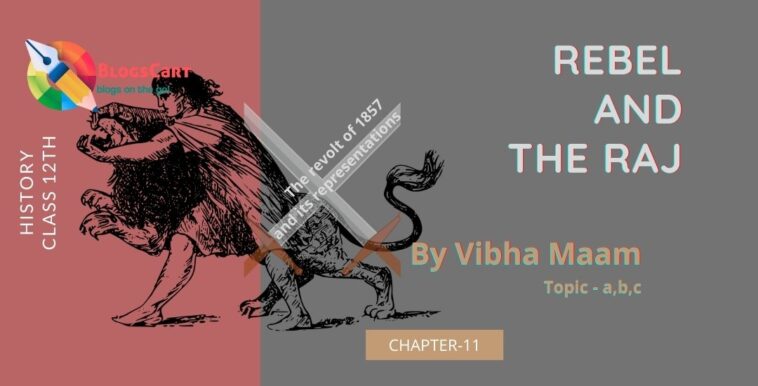Checkout handpicked notes of NCERT class 12th History Chapter 11 Rebel and the Raj topic a, b & c notes by Vibha Madam, and share it with your friends and classmates.
Rebel and the Raj notes by Vibha Mam
The revolt of 1857 and its Representations
10 May 1857, a mutiny spread in Meerut cantonment by sepoys.
It began in the lines of the native infantry, spread very swiftly to the cavalry and then to the cities.
Pattern of the Rebellion
- As the news of the mutiny spread from one city to the next, the sepoys would be ready with their arms.
- The sepoys began their action with a signal like, firing of gun or sounding of the bugle in the evening.
- They first seized the ‘Bell of Arms’ and plundered the treasury.
- They attacked government buildings and burned all records.
- They cut telegraph lines and attacked upon Whitemen.
- When ordinary people began joining the revolt, they targeted the money lenders and rich people.
- There were similarities in the planning and coordination of the revolt in different places.
- There was supposed communication between the sepoy lines of various cantonments.
- Sepoys and their agents moved from one station to another.
- Charles Ball wrote that Panchayats were a nightly occurrence in the Kanpur sepoy line where some of the decisions were taken collectively.
- The sepoys were the makers of their own rebellion.
- The sepoys of Meerut moved towards Delhi to demand the Bahadur Shah Zafar to accept the leadership of the revolt.
- They were the nominal leader of the rebellion.
- In some places like Kanpur (Nana Sahib), Jhansi (Rani Lakshmibai), Arrah-Bihar(Kunwar Singh), Awadh (Birjis Qadr, son of nawab Wajid Ali Shah) assumed the leadership of the uprising.
- In some places rebellion was carried by ordinary people, religious men, local leaders, zamindars and tribals.
- Shah Mal from UP (Baraut) and Ganoo, a tribal cultivator from Singhbhum (Chhota Nagpur) were the leaders of the rebel.
- Maulvi Ahmadullah Shah defeated Henry Laurence in the battle of Chinhat and played an important role in the revolt of 1857.
Rumours and Prophecies
Prophecies
- Captain Wright wrote in magazine about “low caste” Khalasi, when a Brahmin sepoy refused to give him drinking water because of his low caste, the Khalasi retorted “You will soon lose your caste when you have to bite greased cartridges with the fat of cows and pigs”.
- Another prophecy that British rule would come to an end on the centenary of the battle of Plassey on 23rd June 1857.
Rumours
- Sepoys of Meerut had said that bullets coated with the fat of cows and pigs and that biting those bullets would corrupt their caste and religion.
- One another rumour was that the British had mixed the bone dust of cows and pigs into the flour and sold it in the market to destroy the caste and religion of Hindu and Muslims. They wanted to convert Indians to Christianity.
Why did people believe in the rumours?
- Rumours circulate only when they resonate with the deeper fears and suspicions of people.
- The British pursued many reforming policies, introducing western education, western ideas and institutions, western science and established laws to abolished Sati Pratha and permit to remarriage of Hindu widows
- The British annexed many kingdoms and territories by refusing to recognise adoption and charging of mismanagement like Awadh, Jhansi and Satara and
- Introducing their own system of administration, their own method of land settlement and land revenue collection. These were more oppressive, alien and impersonal; this perception was aggravated by the activities of Christian missionaries.
Awadh in Revolt
- The subsidiary alliance was imposed by lord Wellesley (the Governor-General of India 1789-1805) on Awadh in 1801.
- The subsidiary alliance was a treaty between the British East India company and the princely states of India which forced the rulers to surrender their authority and sovereignty to the British.
- By this alliance, the Nawab had to disband his army forces and allow British forces in his territory.
- Nawab had to appoint a British Resident in his court and rule his Kingdom according to the advice of him.
- Deprived of his army, the Nawab became incapable of maintaining law and order and control over the rebellious chief and talukdars in his kingdom.
- In the meantime, the British became increasingly interested in acquiring the territory of Awadh because of its richness of producing Indigo and cotton and also ideally located to develop a principal market of North India.
- When the Nawab failed to pay for the subsidiary forces, in 1858 Awadh was annexed by the British on the charges of mismanagement of the state and Nawab Wajid Ali Shah was dethroned and exiled to Calcutta.
- Nawab was widely loved and the popular ruler. The removal of the Nawab led to the dissolution of the court and its culture, and the sacking of the army of Awadh left several nobels, officials and soldiers out of their jobs, this increased unemployment and poverty in the state.
- The Britishers took away lands from the Talukdars.
- The Talukdars were disarmed and their forts destroyed.
The Summary Settlement of 1856
- After annexation, the first British revenue settlement was known as the Summary Settlement of 1856.
- Britishers assumed talukdars as interloper and not original owners of the land.
- They had established their hold over land through force and fraud.
- The summary settlement proceeds to remove the talukdar wherever possible. British land revenue officers believed that by removing talukdars they would be able to settle the land with the actual owners but this did not happen.
- Though the flow of revenue increased, peasants were still oppressed.
- The dispossession of talukdars breaks down the entire social order.
- The pre-British time the taluqdars were oppressors but many times they appeared to be generous father figures.
- In times of hardship or crop failure, talukdars reduced the revenue or postponed the collection.
- Peasants get loan and support by the talukdars in festive times and needs, but they were totally exploited by over assessment of revenue and inflexible method of collection by the British.
- Many of these taluqdars were loyal to the Nawab of Awadh and joined Begum Hazrat Mahal in Lucknow to fight the British.
- For decades, the sepoys were discontented with low levels of pay and the difficulty of getting leave.
- The decade of 1820, the relationship between the sepoy and the white officers was friendly.
- In the 1940s, this began to change.
- The officials developed a sense of superiority and started treating the sepoys as their racial inferiors.
- The distance between sepoys and officers grew. Trust was replaced by suspicion. Greased cartridges were a classic example of this.
- Awadh was called the ‘nursery of the Bengal army’ because the large majority of the army were recruited from the villages of Awadh and North Uttar Pradesh from upper caste peasants.
What the Rebels Wanted
1)The Vision of Unity
- The Rebel proclamation in 1857 repeatedly appealed to all sections of the population, irrespective of their caste and creed, to join the fight against the British.
- The British had tried a lot to create divisions between Hindus and Muslims during the uprising but they failed.
2) Against the symbols of oppression:–
- The rebels’ proclamations completely rejected everything associated with British rule or firangi Raj.
- The rebels enraged with the British land revenue settlements which had dispossessed landholders and ruined artisans and weavers.
- The rebels wanted to restore the pre-British world of the eighteenth century. A fear of ‘conversion of religion’ led people to believe many of the rumours that circulated at the time.
- The rebels urged people to come together and fight to save their livelihood, their faith, their honour, their identity- a fight which was for the “greater public good“.
- The rebels wanted a more egalitarian society and overturned traditional hierarchies. Rebels against all oppressors.
3)The Search for Alternative Power
- Once British rule had collapsed, the rebels in places like Delhi Lucknow and Kanpur tried to establish some kind of structure of authority and administration.
- The administrative structures established by the rebels were primarily aimed at meeting the demand of war.
- In Awadh, the resistance to the British lasted longest, plans of counter-attack were being drawn up by the Lucknow court.
- Mangal Pandey who was an Indian sepoy in the 34th Bengal native infantry regiment.
- Last Mughal emperor Bahadur Shah Zafar (nominal).
- Cartridges were greased with cows’ and pigs’ fat.
- Lord Wellesley
- The subsidiary alliance was a treaty between the British and princely state rulers which forced the ally to surrender their authority and sovereignty to the British.
- Residents were the political agents of the governor general, who was appointed in the court of the alliance princely states to serve their services for the interest of the company.
Don’t forget to comment in the comment section below to appreciate the hard work of our author by sharing this notes with your known person you can also Contact us for any query or if you are interested in writing with us.
Stay tuned for more amazing stories, poems & articles like this.
Click here to read first part of this chapter.
Use Canva for amazing images.











Awesome 👌👌👌👌👍
awesome notes maam
👌👌
Kn